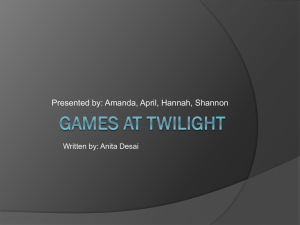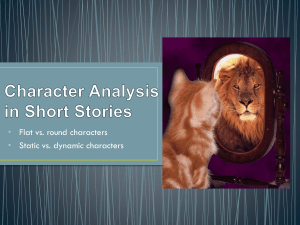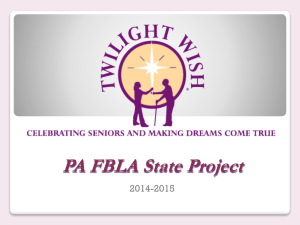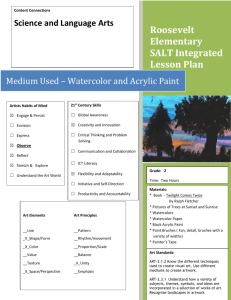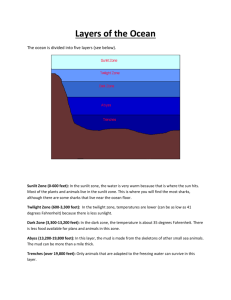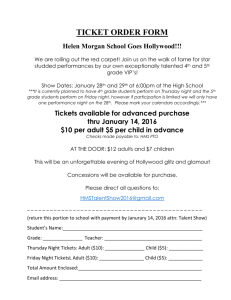Selection A - Danika Barker
advertisement
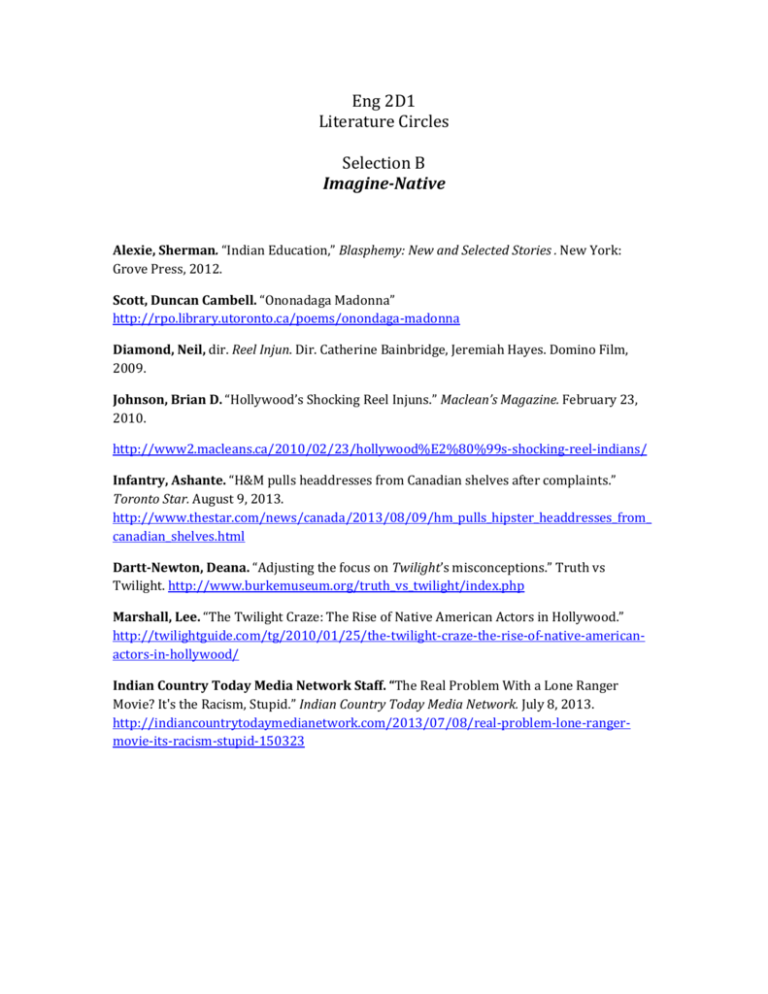
Eng 2D1 Literature Circles Selection B Imagine-Native Alexie, Sherman. “Indian Education,” Blasphemy: New and Selected Stories . New York: Grove Press, 2012. Scott, Duncan Cambell. “Ononadaga Madonna” http://rpo.library.utoronto.ca/poems/onondaga-madonna Diamond, Neil, dir. Reel Injun. Dir. Catherine Bainbridge, Jeremiah Hayes. Domino Film, 2009. Johnson, Brian D. “Hollywood’s Shocking Reel Injuns.” Maclean’s Magazine. February 23, 2010. http://www2.macleans.ca/2010/02/23/hollywood%E2%80%99s-shocking-reel-indians/ Infantry, Ashante. “H&M pulls headdresses from Canadian shelves after complaints.” Toronto Star. August 9, 2013. http://www.thestar.com/news/canada/2013/08/09/hm_pulls_hipster_headdresses_from_ canadian_shelves.html Dartt-Newton, Deana. “Adjusting the focus on Twilight’s misconceptions.” Truth vs Twilight. http://www.burkemuseum.org/truth_vs_twilight/index.php Marshall, Lee. “The Twilight Craze: The Rise of Native American Actors in Hollywood.” http://twilightguide.com/tg/2010/01/25/the-twilight-craze-the-rise-of-native-americanactors-in-hollywood/ Indian Country Today Media Network Staff. “The Real Problem With a Lone Ranger Movie? It's the Racism, Stupid.” Indian Country Today Media Network. July 8, 2013. http://indiancountrytodaymedianetwork.com/2013/07/08/real-problem-lone-rangermovie-its-racism-stupid-150323 Literature Circle Overview Over the next few weeks, you will be working with a selection of fiction and non-fiction pieces in a variety of different media--both poetry and prose-- based on a particular theme or topic. You will get a chance to read all of the packages before you choose the one that interests you the most. Once everyone has selected, you will be put in literature circles. Literature circles should foster rich discussion about each piece. Your ideas and those of the other members of the group will help you produce quality work. Each member of the literature circle will submit the following pieces of writing: 3 Journals 2 Responses to Questions In addition, you literature circle group will give a seminar which will focus on the particular theme presented in your package. Suggestions and Reminders Take rough notes to support the literature circle discussions and your responses to the required activities. Look ahead to see the expectations for each selection. It will help you and your group to focus on the required tasks. You cannot take the packages home. If you need to review any material, then copy the web address and access it from home. All written assignments must be submitted in MLA format. Everyone must share the presentation time for the group seminar. Although you are sharing ideas with other members of the group, all marks are individual. You may choose the same activity as another member of your circle, but you cannot submit an identical assignment. Your teacher will be grading learning skills throughout the literature circle activities. If you are absent for the literature circle sessions, you are expected to speak with the members of the circle to find out what material was missed. You are still responsible for you role in the literature circle. Begin Reading: 1. 2. The Onondaga Madonna Scott, Duncan Campbell (1862 - 1947) 1 She stands full-throated and with careless pose, 2 This woman of a weird and waning race, 3 The tragic savage lurking in her face, 4 Where all her pagan passion burns and glows; 5 Her blood is mingled with her ancient foes, 6 And thrills with war and wildness in her veins; 7 Her rebel lips are dabbled with the stains 8 Of feuds and forays and her father's woes. 9 And closer in the shawl about her breast, 10 The latest promise of her nation's doom, 11 Paler than she her baby clings and lies, 12 The primal warrior gleaming from his eyes; 13 He sulks, and burdened with his infant gloom, 14 He draws his heavy brows and will not rest. Notes 1]Onondaga: native people originally found in New York and Canada. 3. Hollywood’s shocking reel Indians A new documentary chronicles the absurd misrepresentation of native people onscreen by Brian D. Johnson on Tuesday, February 23, 2010 As Avatar completes its quest for world domination, critics are still circling the wagons, asking if James Cameron’s visionary epic is revolutionary or retrograde, or both. The Vatican frets about its creed of nature worship. U.S. Conservatives condemn it as antimilitary eco-liberalism. And the rest of us wonder how the characters in this 3-D marvel can be so flat. But there are Aboriginal people who have a more personal gripe. The Na’vi aliens on Pandora are clearly patterned on North American natives, or more specifically their Hollywood stereotype—noble savages in braids riding bareback with bows and arrows. And as in Dances With Wolves, their messiah is a white man who goes native. “Avatar angered me,” says CBC film critic Jesse Wente, an Ojibwa. “You have blue aliens with tails—why do you have to put feathers in their hair? The Na’vi even do the war whoop, which is a sound completely manufactured by Hollywood.” Those persistent Indian clichés are the subject of a new documentary called Reel Injun, directed by Cree filmmaker Neil Diamond. By turns funny and shocking, it’s a chronicle of how native people have been absurdly misrepresented onscreen from the days of silent film to the present. Growing up on a reserve in the James Bay community of Waskaganish, Diamond, now 41, remembers watching old movies as a kid in a church basement. “Raised on cowboys and Indians, we cheered for the cowboys,” he says, “never realizing that we were the Indians.” When he moved south, his new classmates asked this Cree from the Subarctic if he lived in a teepee and rode horses, because that was the image of Hollywood’s all-purpose Plains Indian. With a mix of movie clips and talking heads, Reel Injun unearths some fascinating examples of inauthenticity. The Indian headband, it seems, was largely a Hollywood invention—for an actor doing stunts and falling off horses, it kept his wig in place. Indian dialogue was often just as fake. In one vintage western, it’s just English played backwards. In A Distant Trumpet (1964), Navajo speak their own language, but after Diamond heard stories of improv mischief, he had the dialogue translated and found them saying things like “You are snakes crawling in your own shit!” Some clips are more sobering. In The Searchers, cowboys uncover an Indian grave and John Wayne shoots out the eyes of the corpse, saying, “Ain’t got no eyes, he can’t enter the spirit land.” Talk about rough justice. When not portraying Indians as bloodthirsty savages, Hollywood idealized them as unreal icons of a vanishing breed. Traditionally they were white actors in bronze body paint, such as Anthony Quinn (The Plainsman), Burt Lancaster (Apache) and Chuck Connors (Geronimo). But even some of Hollywood’s most famous “real” Indians had a fake pedigree. Buffalo Child Long Lance, star of The Silent Enemy (1930), claimed full native heritage, but was in fact part-white and part-black; he committed suicide once the secret got out. Iron Eyes Cody, who played Indians in some 200 films, from Sitting Bull (1954) to A Man Called Horse (1970), was in fact Sicilian, yet he married an Aboriginal and believed he was one by the time he died. Reel Injun also chronicles some of the real Indians who finally fleshed out the Hollywood stereotype—from Coast Salish Chief Dan George in Little Big Man to Oneida actor Graham Greene in Kevin Costner’s Dances With Wolves. The authenticity of Costner’s epic marked a genuine breakthrough, but a number of native critics, including Wente, view it as a colonial fantasy, a Lakota Lawrence of Arabia, in which Indians still need a white messiah to set them straight. Only with groundbreaking Aboriginal productions, like Atanarjuat (2001), do natives finally get to tell their own stories from the inside. The Hollywood injun may be passé, but he keeps re-emerging in other guises. In the Twilight movies, the war between white vampires and native werewolves is a twist on cowboys and Indians. Avatar, Hurt Locker and Inglourious Basterds lead the Oscar race with 26 nominations combined, and they’re all westerns at heart. Hurt Locker’s hero is another desert cowboy, walking into Iraq’s badlands surrounded by hostiles. Brad Pitt’s posse of Nazi hunters in Inglourious Basterds take no prisoners, but in a brutal mix of genocide metaphors, they do take scalps. And as Pocahontas meets Dances with Wolves in the thin air of Pandora, Hollywood’s palefaces have re-engineered the reel Injun as the strangest avatar of all—a red man in blueface. 4. H&M pulls headdresses from Canadian shelves after complaints H&M got complaints that its headdresses, part of the fast-fashion firm’s summer music festival collection, were offensive to aboriginals. When Kim Wheeler came across a fashion headdress in a Vancouver H&M, the selfdescribed “proud Ojibway/Mohawk woman who fights against cultural (mis)appropriation” voiced her displeasure to the nearest sales clerk, then took a picture of the item and attached it to the email she promptly fired off to customer service. Six days later, the fashion retailer notified the media relations specialist the product would be removed from its stores nationwide. “Feedback from our customers is very important to us; we never meant to offend anybody,” said H&M Canada spokeswoman Emily Scarlett. Following the long weekend, a result, perhaps, of Wheeler’s missive to her Facebook friends, the company had logged three grievances about the $14.95 accessory that had been available in five Canadian branches, including Eaton Centre and Yorkdale, for about a month. “If it had been one or 100 (complaints), the reaction would have been the same,” said Scarlett, who noted it was the first time in her seven years on staff that merchandise was withdrawn due to this type of consumer feedback. The headgear has not wrought controversy in any other jurisdiction, she said. The piece, which originated at H&M’s Stockholm headquarters, was part of H&M Loves Music, a collection of music festival-geared clothing and accessories. In her letter, Wheeler called the “faux First Nations headdresses” a “grievous oversight of cultural sensitivity. “As you may not be aware, headdresses are worn by chiefs in some of our communities, but not all, as we are not a pan-indigenous culture,” she wrote. “It is a symbol of respect and honour and should not be for sale as some sort of cute accessory. . . I hope that you can see how this item is offensive and helps to perpetuate cartoon-like negative stereotypes of our proud heritage.” “What I see going on here with H&M is something quite different than the whole ongoing ding-dong about the Redskins name, for example,” said York University marketing professor Detlev Zwick. (Native Americans have spent years lobbying to change the Washington, D.C., football team’s name). “A Swedish, fast-fashion designer house considers a relatively free-wheeling variation on traditional aboriginal headwear entirely unproblematic, because back in Europe it probably is. “When you bring this fashion item into a new context, such as Canada, with its troubled imperial history towards the First Nations, well, the meaning of the same thing changes. “Now, you very likely would not see H&M make the same mistake with some variation of the Star of David as (an) accessory for your latest summer jacket, given the use of this symbol by the Nazis.” Wheeler plans to remain vigilant. “It really is about continuing the education of non-aboriginal people,” she said. “And if we have to keep explaining to them over and over again why it’s wrong, why it’s culturally insensitive, then I’ll keep doing that.” 5. The Twilight Craze: The Rise of Native American Actors in Hollywood For decades, stereotypes were a common place for Native American roles who were not even played by the indigenous but rather Caucasians who wore long black wigs and whose faces were painted with red and brown makeup. Once the public made a demand for more “authentic” Native Americans, other races filled the parts such as Philippines, Asians and Latin Americans. Since the arrival of one the most successful box office hits, Twilight, the question of Native Americans in Hollywood once again rises. Native American Influences in Twilight In the sequel to Twilight movie, New Moon, there is a Native American tribe that is represented, the Quileute tribe, which is able to transform into strong and powerful wolves who hunt and slay vampires. Some of the actors in this wolf pack are from native American decent which has paved way for fellow natives to show their acting talents and that there is a lot of room in Hollywood for the misrepresented roles of Native Americans. Although some of the Twilight craze has been fueled with some Native Americans continuing to be upset by their portrayal, many of the twilight actors have become advocates for the Native Americans and have shed some light on the thoughts of Native American actors in Hollywood and in Hollywood films. Many stereotypes have portrayed Natives for years such as their infamous use of feathers, leather and long hair. The Native American New Moon actors Alex Meraz and Chaske Spencer have confessed that New Moon is a new type of History in Hollywood concerning Native Americans, where they are finally able to shed many of the previous Hollywood stereotypes concerning indigenous tribes. Twilight Controversies Regarding Indigenous Tribes Is the new Twilight movie, New Moon, free from indigenous stereotypes? No, but improvements have been made. Plus these young actors are finally encouraging others to embrace their roots. One large controversy has been that the wolf pack cast of Twilighters discovered their roots after having been chosen for the role which has outraged the Native American community. The principal Werewolf, Jacob Black, played by Taylor Lautner caused a stir of controversy because he learned about his roots after the fact of being cast as Jacob. Many were doubtful as to his lineage concerning that he found out after being cast in the role. However, without this role, these young actors may have never even discovered their family lineages. Either way, the New Moon movie has certainly opened the door for many Native American actors who are embracing their new found culture and encouraging others to do so as well and the Twilight sequel has also changed the way audiences view Native Americans in film, furthering them from the stereotypes of “old Hollywood.” The Twilight series, which has a vital role for Native Americans in New Moon and Eclipse, the third installment of the Twilight Franchise, will most likely be one of the first Native American influences that young audiences view. Twilight creator, Stephanie Meyer, has given each character their own unique personalities and traits which show the more human side of Native Americans, rather than the stereotyped and generalized indigenous view that other movies have displayed. A Time of Change More and more, Native American actors can fight for their rights in Hollywood to be cast in the roles in which they represent. No longer do these parts need to be filled by others who most likely do not understand the indigenous roots of the character. Also, considering the decreasing population of Native Americans and for those who have lost touch with their indigenous roots, the Twilight movies help audiences to get in touch with their ancestry and to embrace their culture, no matter how out of touch they have been. In a way, Twilight has made it cool to embrace one’s indigenous roots rather than to hide any trace as before. Despite the controversy that Hollywood has caused with its practices of casting, Native Americans are finally beginning to develop in their roles and story lines in Hollywood films as shown in Twilight. This movie franchise is a monumental step for indigenous actors in America. It is also a gateway for non indigenous people to view more accurate indigenous characters than those of the past, forever changing how the world sees Native Americans through film. 6. The Truth Versus Twilight Misrepresentations Gone Wild Made famous by the recent pop-culture phenomenon Twilight, the Quileute people have found themselves thrust into the global spotlight. Their reservation, a once quiet and somewhat isolated place, is now a popular tourist destination for thousands of middleschool-age girls and their families. In the wake of the popularity of the book and film saga, the Quileute Tribe has been forced to negotiate the rights to their own oral histories, ancient regalia and mask designs, and even the sanctity of their cemetery. Quileute responses to the Twilight book and film series have been as diverse as the community itself. Some have enjoyed the newfound public interest in their culture, while others find the whole story and all the attention distasteful. And still others are not interested in the hype and see this phenomenon as a phase that will fade soon enough. In collaboration with the Quileute Tribe, this site seeks to inform Twilight fans, parents, teachers, and others about the real Quileute culture, which indeed has a wolf origin story, a historic relationship with the wolf as demonstrated in songs, stories, and various art forms, as well as a modern, multi-dimensional community with a sophisticated governance system. We also hope to offer a counter narrative to The Twilight Saga’s stereotypical representations of race, class, and gender, and offer resources for a more meaningful understanding of Native American life and cultures. The High Price of Fiction The phenomena of the Twilight series has had vast economic benefits for Summit Entertainment, Stephenie Meyer, the tiny town of Forks, Washington, and even Nordstrom department stores, but the Tribe whose culture was represented for background fodder in the teenage love story, has seen little benefit. In addition to shedding light on the appropriation of Quileute culture, we wish to expose how the Twilight saga has presented a skewed version of modern Native American life and to offer visitors to this site an alternative perspective with links to resources for a more meaningful understanding of Indians in the modern era. Native Women of Twilight As the Quileute wolf pack drives most of the drama in Twilight, especially in Eclipse and Breaking Dawn, the few Native women, particularly Emily Young and Sue Clearwater, may provide the most insight—not to actual roles of Native women on the reservation—but into Meyer's ideas of Native women's roles. These two characters demonstrate prevalent stereotypes and provide examples for the very topics Native feminists address in their scholarly work. Passive and Subservient Native Women? Total Fiction! Emily Young is the most prominently featured Native female character in Twilight as fiancée to Sam Uley, alpha of the wolf pack. In this role she is also implicitly the caretaker of all the wolves/boys. Emily, as a subservient to Sam, exemplifies not a traditional role of women in the Native family, but rather a more sexist Western gender role. Native women, in contrast, are often leaders and decision-makers in the household rather than solely the cooks and caretakers of the men. Today, women are often prominent leaders on Tribal Councils (such as the current Quileute Chairwoman, Bonita Cleveland), teachers, and activists in their communities. Women's roles have historically been equal to the roles of men and this holds true today. A troubling message of the Twilight saga is the disfiguring scar that covers the right side of Emily's face, a scar caused by Sam's violent and uncontrollable nature. Since none of the Cullens are scarred in this way, the image of domestic violence as an accepted part of Native relationships is a possible interpretation. The frightening reality is that contemporary Native American women represent the highest statistic of domestic violence victims and deaths (Smith, 116-132). To portray Sam's abuse of Emily— regardless of his intention or his remorse after the fact as part of the commitment of imprinting or blind love, is irresponsible. Furthermore, that Emily claims the scars were the result of a bear attack in order to cover for Sam exemplifies the author's total disregard or ignorance of real Native issues. In addition, a young woman on a reservation would have the support of her family and community around her—while Emily is portrayed as having nobody in her social circle but a group of hot-tempered, young men. Elder(?) Woman Leader—Only in the Absence of Her Man An even more marginal Twilight character, Sue Clearwater represents the quiet dignity of a Native elder and a leader in the community. Alex Rice, the lovely actress chosen for the role of the dignified elder and mother of two teens in Twilight, played a teen herself as Sacagawea in the National Geographic film, “Lewis and Clark: Great Journey West (2003)” only eight years ago. Based on these numbers, by the greatest stretch of mathematical imagination, the actress might be in her mid-twenties at the oldest. Yet Summit Entertainment found her to be the best candidate for the role (and the only portrayal) of an elder woman. Her role in the saga becomes important as her husband Harry Clearwater dies: Sue automatically takes his place on the Tribal Council in his absence. While this may allude to the rise of Native women in power (Pember, 11-12), The Twilight Saga, in this chain of events suggests that the widow or widower of a Council member assumes Council responsibilities only upon the death of their spouse. This is false. If this were a real scenario, Sue Clearwater could have indeed been voted onto Council because of her knowledge of the culture, adherence to traditional values, and standing in the community—but to portray her as stepping in for her husband oversimplifies Tribal political processes and shows the author's ignorance of contemporary Native life, Quileute or otherwise. While women in leadership roles might seem relatively progressive according to Western standards, Native women have always maintained roles of authority, taking responsibility for preserving values and culture within the family and among the community (Ibid). The role of Sue Clearwater quickly shifts away from a leader on Council to a more passive and domestic role as a caregiver to the needy character Charlie Swan. Top: Emily serves snacks to wolf-pack boys. (Image: Summit Entertainment) Middle: Tinsel Korey as Emily in "New Moon." (Image: Summit Entertainment) Bottom: Alex Rice as "Sacagewea." (Image: National Geographic Television) 7. The Real Problem With a Lone Ranger Movie? It's the Racism, Stupid ICTMN Staff July 08, 2013 The hysteria over Johnny Depp as Tonto is (probably) in its dénouement: The Lone Ranger opened to terrible reviews and disappointing box office numbers, and American Indians who didn't like the idea of Depp as a Native icon were to some extent vindicated. There will be some pieces to pick up and some lessons learned, but a lot of questions have been answered. Here's one that is still up for debate: Was the Lone Ranger story simply too much of a relic from less enlightened times? Was the whole shooting match, as Jason Bailey writes at Flavorwire, "too racist to reboot"? Bailey notes that, despite Depp's lip service to a Tonto who would break with tradition, the character as played still "maintains the most culturally damaging element of the role, his definite article-free dialogue, with lines like, 'Do not touch rock. Rock cursed.'" Bailey describes the plotline of The Lone Ranger as a narrative that has been "twisted ... into pretzels" to try not to be racist -- and yet still is. The entire concept of the Lone Ranger and Tonto -- a team up that was historically unlikely, to put it mildly -- might just be unredeemable. Bailey brings up Shakespeare's play The Merchant of Venice, which was made into a major film as recently as 2004, and says "maybe we just don’t need to tell this story anymore, since it — though a classic, and an important piece of literature, etc. etc. — is deeply, unavoidably, problematically anti-Semitic." In a long interview posted to the Moviefone Canada site, Jesse Wente of the Toronto International Film Festival grants that those involved with the film may very well have intended to empower Tonto, but ended up with a character that is less progressive than the Native sidekicks played by Chief Dan George in The Outlaw Josey Wales(1976) and Gary Farmer in Dead Man(1995). And ultimately, Wente said, there is just a problem with the traditional Western. "Because of the nature of the Western, its ties to the idea of nationhood, particularly in the U.S.," he said. "These stories were, with Manifest Destiny, fundamental nation building [myths] for the U.S. If you think about the classic era of the Western, from the early '30s to the '50s, it came when the States was still a very young country and still needed to tell itself the story of its own origins, and this was the story it told. Unfortunately, it was told at the expense of the first inhabitants of this land because it altered the history, the truth of what happened. To me this film recalls a lot of those issues." An article at Time.com suggested that "the issue isn’t so much the casting as it is the character." Adrienne Keene of Native Appropriations pointed out that Tonto is, unfortunately, one of just a few Native people -- real or fictional -- that non-Indians know of. The risk is that his quirks or character traits may be applied to an entire race: "Without an accurate pop-culture idea of a real-life Native American in moviegoers’ heads, Tonto is less of an individual character than he is a key piece of the popular image of a large and diverse population. The stereotype is particularly detrimental for its fantastical elements, [Keene] believes: when a real group of people seems as mystical as say, werewolves, in every popculture depiction of the group, it gets hard to pay any attention to the real people who are alive today and have real issues and achievements of their own." In a piece for Slate entitled "Johnny Depp’s Tonto: Not as Racist as You Might Think. But Still Kind of Racist," Aisha Harris was more forgiving than others, but still couldn't get past the limitations of the source material. "Depp’s attempt to be a 'warrior' role model to all the American Indian kids lucky enough to watch him save the day fails—and for the simple reason that the original material is too entrenched in an essentially racist ideology." It appears that, despite the filmmakers' intentions, The Lone Ranger did not reinvent Tonto or the Tonto-Ranger dynamic -- and perhaps it's because America has simply moved on. Is there any reinventing of Unce Remus from Song of the South, or Chop Chop from the old Blackhawk comic books? Arguably not. While a Native actor such as Adam Beach (often mentioned as a better fit for Tonto) might have been a more pleasing casting choice, in this case Depp's insistence on playing Tonto actually saved a Native actor the awkwardness of trying to sell viewers a story they were never going to buy. Procedure A. Readings and Literature Circle Meetings 1. Ensure you have read all the selections in this package. 2. Write point form notes on each of the pieces in this package. Write about the feelings, thoughts, and ideas you experienced as you read each piece. Use specific references from the text to support your view. For each selection, you need to be prepared to share at least 2 observations (with supporting details) and one discussion question. 3. Share your responses with the group. Your teacher will give you more specific instructions for the actual literature circle meetings. Discuss and debate. As you listen to the opinions of the other group members, you may return to your notes and make any revisions you deem necessary. __________________________________________________________________________________________________________ B. Journal Responses Choose three of the texts from this package and write a formal journal response for each (see the rubric at the end of this package for more details). You may find that the ideas from the group helped you form an opinion or changed your feeling entirely. That’s just fine. This is a time for you to reflect on these issues before you continue working on the rest of the package. Submit these three journals in good copy. You cannot use these three selections for the next activities. __________________________________________________________________________________________________________ C. Questions 1. You must choose two texts to complete questions for. You cannot choose the same texts you chose for your journal submissions. Each response should be around 500 words (approximately 2 pages typed, double-spaced). Use specific references from the text for support. Use parenthetical referencing, please. 2. Take turns discussing your choices and responses with members of the group. Use their ideas to help create a meaningful response. Everyone in the circle needs to help each other. 3. Once everyone has rough drafts of the two responses, exchange papers and perform a peer edit. 4. Submit your two responses in good copy. Questions First a note on terminology in Canada: Aboriginal is an all-encompassing term that includes Inuit, First Nations (Indians), and Métis. "First Peoples" is also an all-encompassing term that includes Inuit, First Nations (Indians) and Métis. Aboriginal and First Nations are NOT interchangeable terms. "Aboriginal" and "First Peoples" ARE interchangeable terms. Inuit is the contemporary term for "Eskimo". First Nation is the contemporary term for "Indian". Inuit are "Aboriginal" or "First Peoples", but are not "First Nations", because "First Nations" are Indians. Inuit are not Indians. 1. Alexie, Sherman. “Indian Education,” Blasphemy: New and Selected Stories . New York: Grove Press, 2012. 1) Provide an example of how Alexie uses repetition in this short story. What literary purpose do you think it serves. Is it effective? Why or why not? 2) The teachers in this story are cruel and vindictive at worst and weak-intentioned but naïve at best. Agree or disagree using specific examples from the text. 3) Alexie often uses juxtaposition to show the difference between the main character’s school-world and his real life. Provide an example of this and explain what the juxtaposition helps to highlight about these two different worlds. 4) Provide an example of irony from this short story and explain what makes it ironic. 5) In a paragraph, explain your personal response to the story. What is the overall impression it leaves you with? Knowledge /10 Thinking /10 Communication /10 Application /10 2. Scott, Duncan Campbell. “Ononadaga Madonna” 1) In this poem, Scott paints a portrait of a woman holding a child. While there is no action in this poem, there is a great deal of conflict being depicted. Explain this conflict. Who or what is the conflict between? 2) What do you think Scott’s attitude is toward the subject of this poem? Explain which words or phrases helped you draw this conclusion. 3) There are several words and phrases in this poem that illustrated stereotypical views of First Nations people. Identify and explain three of these words or phrases. 4) The title of this poem contains a reference to a particular kind of painting. Do a Google search for “Madonna with Child” to see examples. Then explain the significance of the title. Knowledge /10 Thinking /10 Communication /10 Application /10 3. Diamond, Neil, dir. Reel Injun. Dir. Catherine Bainbridge, Jeremiah Hayes. Domino Film, 2009. Selected clips. and Johnson, Brian D. “Hollywood’s Shocking Reel Injuns.” Maclean’s Magazine. February 23, 2010. 1) In Reel Injun Diamond’s thesis is that Hollywood has manufactured the image that most non-Aboriginal people identify as being “Indian.” Identify three specific examples of this stereotypical representation. 2) What is so problematic about the way Hollywood has represented Aboriginal people? (Explain in well-developed paragraph making specific reference to the article or film clip.) 3) Johnson makes the case that modern movies like Avatar and Twilight are just reimagined versions of the old stereotypical cowboy and Indian westerns. Is this a valid argument in your opinion? Why or why not? 4) Critic, Jesse Wente thinks that while Dances with Wolves represents a breakthrough, it is still problematic. Explain both the pros and cons of this film. 5) How does the author create both unity and coherence in the opening and closing paragraphs? * * Unity means the writing is 'unified'. When each word and sentence seems to be leading its reader towards a greater understanding of the overall theme or controlling idea, then the writing is said to be unified- it exhibits unity. Coherence means that each part of the writing appears to be 'connected' and heading towards a single conclusion or goal. Coherent writing appears to flow naturally and seamlessly in both style and sense. Knowledge /10 Thinking /10 Communication /10 Application /10 4. Infantry, Ashante. “H&M pulls headdresses from Canadian shelves after complaints.” Toronto Star. August 9, 2013. 1) This is a news article. Create a chart and identify how the article answers the 5Ws plus H (Who? What? When? Where? Why? How?) 2) How is the information in the article organized? Use evidence to support your answer. 3) The article states that Kim Wheeler “fights against cultural (mis)appropriation.” Do a little research and learn more about the idea of cultural appropriation. What does it mean? If I wore a pair of moccasins I bought from an Aboriginal craftsperson is that cultural appropriation? Cite your sources. 4) H&M isn’t the only company to be accused of cultural appropriation recently. Do some research on Urban Outfitters and cultural appropriation. 5) There’s a lot of debate about this issue. Some people say that it’s just fashion and not a big deal. Others claim that it’s disrespectful and shows a lack of understanding about Aboriginal culture. What do you think? Knowledge /10 Thinking /10 Communication /10 Application /10 5. Marshall, Lee. “The Twilight Craze: The Rise of Native American Actors in Hollywood.” 1) This is an article that was originally posted on a fan blog rather than a book, or news source that has been carefully edited before publishing. There are a number of small errors in the piece in terms of capitalization and punctuation. There are also many sentences that are confusing either due to construction or poor word choice. Identify three confusing sentences and explain why they are confusing (you can’t just say the sentence is too long). 2) Using the rubric below, indicate the level in each category you think this writer has achieved. Then provide constructive comments: strengths, weaknesses, next steps. (Write comments on the lined paper with the rest of your answers please.) Level 1 Level 2 Level 3 Level 4 Knowledge Demonstrates limited knowledge and understanding of content. Is this research or opinion? Demonstrates adequate knowledge and understanding of content. Writer has done some research and understands elements of this topic. Demonstrates considerable knowledge and understanding of content. Writer has clearly done research and understands most elements of this topic. Demonstrates excellent knowledge and understanding of content. Writer has clearly done thorough research and understands all elements of this topic. Thinking Support is present but may not be sufficient. Paragraph order makes no sense. Support helps thesis. Paragraphs are inconsistently organized. Support is well- chosen and supports thesis. Paragraphs are organized fairly clearly. Supporting points are thoughtfully chosen and supports thesis. Paragraphs are organized clearly. Communication Numerous errors in spelling, grammar, verb tense, and punctuation. May appear to be a rough draft. Contains multiple formatting errors. Ideas lack clarity in expression. More than 5 small errors and some major errors in spelling, grammar, verb tense, and punctuation. Contains a number of small formatting errors. Ideas are expressed clearly. More than 5 small errors in spelling, grammar, verb tense, and punctuation. Mostly demonstrates proper MLA format. Ideas are expressed clearly and sufficiently. Minimal errors in spelling, grammar, verb tense, and punctuation. Demonstrates proper MLA format. Ideas are organized and expressed clearly and sufficiently. Application Analysis only at surface level Analysis mostly at surface level Analysis goes beyond the surface meaning. Writer ignores or misses the more complex issues Writer draws conclusions that go beyond the obvious Analysis goes well beyond the surface meaning. Writer draws conclusions that go well beyond the obvious Writer failed to address complex issues. 3) In spite of the faults in this writing, do you find the author’s argument convincing? Why or why not? Knowledge /10 Thinking /10 Communication /10 Application /10 6. Dartt-Newton, Deana. “Adjusting the focus on Twilight’s misconceptions.” Truth vs Twilight. http://www.burkemuseum.org/truth_vs_twilight/index.php 1) This article comes from an American museum’s website. What is the purpose of the site according to the article? To what extent do you think the author achieves this purpose? 2) In the introduction how does the writer indicate (indirectly) that her site is a credible source of information? 3) What further evidence do you see in the article that suggests that it might be a credible source of information? 4) Summarize three main critiques that the author makes about the Twilight movie franchise. Do the critiques seem valid? Explain your answer. Knowledge /10 Thinking /10 Communication /10 Application /10 7. Indian Country Today Media Network Staff. “The Real Problem With a Lone Ranger Movie? It's the Racism, Stupid.” Indian Country Today Media Network. July 8, 2013. http://indiancountrytodaymedianetwork.com/2013/07/08/real-problem-lone-rangermovie-its-racism-stupid-150323 1) In this article, the author (who is only identified as being a member of the ICTMN staff—not that uncommon) summarizes a number of points made by other movie reviewers. One writer (Bailey) states that some historical texts contain too much racism to remake them in a culturally sensitive way. What do you think? Can we still learn from and appreciate a text while acknowledging the racism in it? Is there a difference between a pop culture story like The Lone Ranger and Shakespeare’s The Merchant of Venice? 2) Adrienne Keene points out that the issue isn’t so much that Johnny Depp was cast as Tonto, but the character of Tonto himself. Summarize her concern about Tonto. Make a connection to something else you’ve read or seen in this package. 3) When we think of stereotypes we often think of negative traits being applied to a whole group of people, but stereotypes are generalizations—they can be positive or negative in nature. What are some of the “positive” stereotypes about Aboriginal people? Explain why these “positive” stereotypes are still damaging. Knowledge /10 Thinking /10 Communication /10 Application /10 __________________________________________________________________________________________________________ D. The Seminar Divide the group so that each member has one of the following roles: The Manager: With the assistance of the group, you will oversee how the seminar is organized. What’s the thesis or controlling idea? What should the hook be? How do we prove or argue the thesis? How should the middle sections be organized? Who is responsible for each section? How should it end? What is the universal application? You need to submit a 1 page point form outline of your seminar before your group presents. The Creator: With the assistance of the group, you are the one who sees how this can be presented so it is an audio/visual masterpiece. You should be familiar with presentation software. You need to see the big picture. You need to see how each person’s part contributes to the whole presentation. Your technical skill will pull everyone’s idea together. The Connector: You see connections: text to text, text to self, text to world. You often find yourself saying, “Hey, this reminds me of . . .” Your job is to think how other pieces of non -fiction or fictional literature, poetry, film, or personal experience connects to your thesis. This person will probably be responsible for the hook and/ or close. This person should be a reader of all types of literature and media, including daily news reports. The Researcher: You enjoy searching databases, journals, and magazines in order to delve deeper into a particular topic. You will work closely with the connector and help the group with their research on this topic. You are responsible for writing the Works Cited page. Everyone: No matter what your role, your group must pull the individual parts together to create a group seminar of 12-15 minutes. Everyone must have equal presentation time Consult the rubric to ensure all requirements have been met. Suggested Steps Organize your seminar using key-hole structure. First: Creating the thesis. 1) How did your group feel about the topics presented in “Imagine-Native”? 2) Your thesis may be the answer to all or one of these questions: Has Hollywood evolved in its portrayal of First Nations, Inuit, and Metis people? Or are they still relying on stereotypes? Why are stereotypes about Aboriginal peoples damaging? Based on the media, what kind of an image of Aboriginal peoples do people see? What is the problem with this? 3) Write a thesis statement. Your thesis will guide your presentation. Second: 1) How will you build the seminar? What should go in the introduction? What is the hook? How will the introduction lead to thesis? 2) What are your supporting arguments for the thesis? This will be the body of your seminar. How are you going to order these? (Chronological? In order of importance?) 3) How about the conclusion? Remember the three parts: restate thesis, summarize arguments, and end with a universal application. End with a bang, not a whimper, please. Third: Begin the preparation. Ensure you work as a group. Support each other. Assign duties. Write the outline. Prepare the script. Rehearse. Ensure everything is in working order including props/technology for audio/visual aids. Fourth: Presentation Day. Journal Rubric Knowledge /10 Thinking /10 Communication Level 1 Level 2 Level 3 Level 4 Limited knowledge of content, literary devices/ stylistic elements, bias Some knowledge of content, literary devices/ stylistic elements, bias Good knowledge of content, literary devices/ stylistic elements, bias Excellent knowledge of content, literary devices/ stylistic elements, bias “Seems like you’re struggling with this. Let’s review the key ideas.” “Might need to review things like literary devices or bias.” “Great work! You might have one or two little things to improve on.” “It’s like you’re an expert on this!” Limited supporting details for each point. Some supporting details for each point. Good supporting details for each point. Excellent supporting details for each point. Superior organizational skills. Insightful critical questions. Superior organizational skills. Insightful critical questions. Superior organizational skills. Insightful critical questions. Superior organizational skills. Insightful critical questions. “I need more examples to support your ideas. I’m having trouble understanding your ideas. Don’t take everything the author says at face value” “I need a few more examples to support your ideas. It was a bit confusing. I need you to think a little more critically.” “Your journal doesn’t leave me with many questions, and I can see you’re questioning what you read.” “Your journal doesn’t leave me with any questions, and I can see you’re really questioning what you read.” Several mechanical errors. Limited paragraph development Poor sentence structure. Major issues with MLA format. A number of mechanical errors. Some paragraph development Mostly accurate sentence structure. Some correct use of MLA format. A few mechanical errors. Good paragraph development Accurate sentence structure. Good use of MLA format Virtually no mechanical errors. Excellent paragraph development Sophisticated sentence structure. Excellent use of MLA format “Good proofreading, but you missed a couple things. Good use of state illustrate, explain.” “Great job proofreading and using the state, illustrate, explain model.” “Did you proofread this? You need to state, illustrate, explain.” /10 Application /10 “You might have a few comma splices or run-ons, but overall I can understand your ideas. Remember to state, illustrate, explain.” Limited use of knowledge of content and literary devices to draw conclusions and make connections Some use of knowledge of content and literary devices to draw conclusions and make connections Good use of knowledge of content and literary devices to draw conclusions and make connections Excellent use of knowledge of content and literary devices to draw conclusions and make connections “No mention of any terms/ideas studied in class. Your response is a bit simplistic. Dig a little deeper.” “You didn’t specifically mention terms/ideas discussed in class but you did make some connections.” “You mentioned a few terms/ideas discussed in class and applied them to what you’re reading. You raised some interesting issues and made connections to other things you’ve read or seen.” “Wow! You specifically mentioned a number of terms/ideas discussed in class. You’ve gone above and beyond in terms of making connections and using literary devices. You raised some intriguing issues.” Seminar Rubric Knowledge Level 1 Level 2 Level 3 Level 4 Demonstrates limited understanding of subject. Demonstrates some understanding of subject. Demonstrates good understanding of subject. Thesis unclear or may be absent. Seminar contains a thesis. Seminar contains an arguable thesis. Demonstrates excellent understanding of subject. Details demonstrate limited or incomplete understanding of texts read. Details demonstrate some understanding of texts read. Attempts to go beyond the obvious to demonstrate deep understanding of texts read. Presentation seems unrehearsed and poorly organized. Presentation shows some evidence of rehearsal and some organization. (May have issues with one or more: props, delays, pacing) Presentation shows evidence of rehearsal and is well organized. Some use of details from the text to support thesis. Good use of details from the text to support thesis. Presenters are sometimes difficult to hear, make limited eye contact. Some “ums, uhs” or nervous giggles. Need notes. Audio/visual elements absent or do not enhance presentation. Presenters attempt to speak clearly, attempt to make eye contact, speak with some expression. Some “ums, uhs” or nervous giggles. May need notes. Presenters speak clearly, attempt to make eye contact, speak with expression. Very few “ums, uhs” or nervous giggles. Limited ability to make connections between different texts read and explain the differences and similarities between them. Some ability to make connections between different texts read and explain the differences and similarities between them. /25 Thinking (Multiple issues with props, delays, pacing) /25 Communication Limited use of details from the text to support thesis. Details may be irrelevant or absent. /25 Application /25 (eg/ props ready, minimal delays, good timing and pacing) Audio/visual elements enhance presentation. Audio/visual elements somewhat enhance presentation. Good ability to make connections between different texts read and explain the differences and similarities between them. Seminar contains a clear, arguable thesis. Goes beyond the obvious to demonstrate deep understanding of texts read. Presentation is highly polished is very well organized (eg/ props ready, no delays, excellent timing and pacing) Excellent use of details from the text to support thesis. Presenters speak loudly and clearly, at a comfortable pace, make eye contact, speak with expression and enthusiasm. Very few “ums, uhs” or nervous giggles. Audio/visual elements enhance presentation. Excellent ability to make connections between different texts read and explain the differences and similarities between them.
